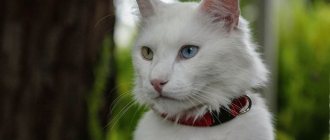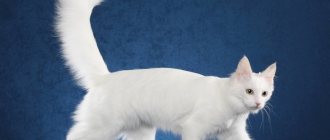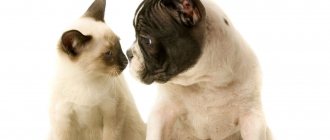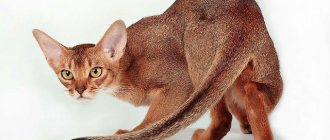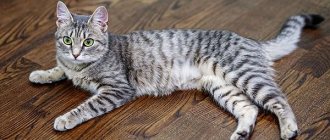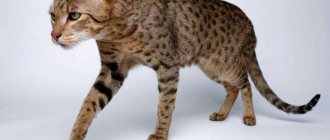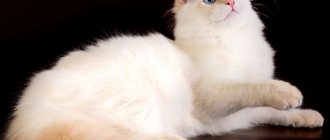A cat capable of conquering with its beauty and sophistication even those who prefer the absolute brutalists of the cat world - measured Britons or independent Scots. The Turkish Angora is beautiful, light, artistic with weightless hair and a piercing gaze, it captivates from the very first moment.
History of the origin of the Turkish Angora breed
If we talk about these representatives of the feline world, then we can say with confidence that this is one of the oldest breeds that has ever existed on our planet. But when it comes to such species, the origins of the pedigree of which go back centuries, then associations involuntarily arise in the head with wars, battles and other disasters that steadily burdened the lives of people, not to mention pets. However, this was not the case with Angora cats.
The thing is that the Turkish Angora cat, according to many historians, was the pet of none other than the Prophet Muhammad himself. For this reason, having such a purr in your home was considered simply the height of luxury. Therefore, Angora cats were the inhabitants of exclusively luxurious mansions and loyal friends of eminent owners. A Turkish Angora kitten, starting around the 14th–15th centuries, was considered a very prestigious and very expensive gift. Such an animal could only go to some official or even the Sultan on a big holiday.
Local residents were very respectful of their aboriginal cats, and in order to express their love and respect for them, representatives of Turkish Angoras had the right to cross the threshold of the mosque, and this was considered the highest measure of favor.
Angora cats gradually began to please not only local residents and their rulers, but also noble people of Europe. For example, once the famous King of France Louis XVI was given a cute Turkish Angora kitten. His Majesty loved his tailed pet so much that the cat was allowed almost everything; the animal could calmly walk around the table, at which great affairs of state were carried out. And at the same time, no one could afford to drive away the annoying, furry “member of the state council.” When hard times came in Europe, the wife of the King of France, Marie Antoinette, did not leave even the cats in trouble, she did her best to save them, transporting her pets far overseas - to the USA. It was there that furry cats from Turkey were officially approved as a new breed; such an important event in the life of Angora cats happened at the beginning of the 19th century.
For a long time, these purrs were simply wildly popular, but since people love everything new, with the advent of new long-haired breeds, the Turkish Angora gradually began to be forgotten. Only after more than 100 years, Turkish officials realized that they had an indigenous breed of cats and devoted a lot of effort and material resources to returning them to their former glory. The Turks succeeded, but since then it has been strictly forbidden to export local Turkish Angoras outside the country. But this does not mean at all that you cannot find an Angora kitten for yourself. If they don’t sell it to you in Turkey, then you can easily buy it in the USA or in nurseries in Europe.
Breeding Angora cats
Before buying a kitten, a breeder needs to know a lot. Mandatory minimum education: cat genetics courses, felinology courses and minimum veterinary literacy. This is very important - only knowledge will allow you to breed healthy and high-quality representatives of the breed.
The work of a breeder is full of worries:
- first of all, it is necessary to constantly participate in exhibitions and receive titles and markings,
- secondly, selling expensive and purebred kittens is very difficult,
- thirdly, you will have to spend a lot of money on a veterinarian, food, and cat supplies.
But if you are ready for all the difficulties and have all the necessary knowledge, then you can choose a cat. There are some things to keep in mind:
- it is better for a novice breeder to purchase a cat or a breeding pair immediately,
- animals should be chosen show or breed class,
- there should be no deaf ancestors in the pedigree of the Angora cat, and the kitten itself must be healthy,
- Be sure to choose cats from a good cattery with all the documents,
- When purchasing, a sales contract is drawn up, which stipulates that the breeder agrees to give the cats for breeding. With the kitten, you must receive its pedigree or birth certificate and veterinary passport.
As soon as you have purchased cats, you must register your cattery and its producers. To do this, you need to contact the breed club or the club of the felinological organization in which the breed is recognized. There you will be given the necessary documents and registration, which will include the name of the club, the number of breeding sires and other necessary information. If you wish, you can also register a nursery seal with the club.
If you decide to spay or neuter your pet, the optimal age for this is 6-7 months.
The next step will be an exhibition where the club's manufacturers need to be presented. There, the cat must receive a rating of at least “very good”, valid for a year, and the cat must receive a rating of at least “excellent”, valid for a year. If desired and possible, the animal can close the title and receive a title certificate, which is valid for life.
After this, you can start looking for a partner. It is better to do this at exhibitions and among nurseries that provide cats for mating. Online platforms and advertisements are not suitable, since you rarely see truly purebred animals there.
Criteria for choosing a partner:
- full compliance with the standard,
- availability of a confirmed pedigree, veterinary passport and a valid divorce appraisal or title certificate,
- if your cat is mating for the first time, then the cat should not be mating for the first time,
- the cat should not be younger than 1 - 1.5 years. The female also mates for the first time no earlier than 1.5 years,
- blood group compatibility. You can find this out from your veterinarian. Compatibility scheme: female of group A - males of groups A and B,
- female of group B - males of group B,
- male of group A - female of group A,
- male of group B - females of groups A and B.
As soon as a suitable partner is found, you need to contact the club where your nursery is registered and get a referral for mating, written down on a special form. If you have two cats, you need to do this for both. The partner must also have a referral from his club.
Mating always takes place on the cat's territory. You need to prepare for mating in advance:
- draw up an agreement stipulating re-mating in case the first one is unsuccessful and payment - in a kitten or in cash,
- transport the cat's belongings to the cat's territory: bowls, a supply of food for 3-4 days, a bed and a scratching post. The owners of the cat must allocate a separate safe room for mating,
- cut the cat’s claws - she may scratch the cat during his “persuasion”,
- wait for the heat and take the cat to the cat for 2-3 days.
How to understand that a cat is pregnant:
- sudden cessation of estrus at an uncharacteristic time for the cat,
- changes in the cat's character and habits,
- a month after estrus, the cat’s stomach noticeably enlarges,
- nipples swell and turn pink starting from the third week, and then vomiting appears in the morning,
- The cat's appetite is growing
- From the third week, the cat can be taken for an ultrasound. If she does not become pregnant, the mating must be repeated during the next heat.
Appearance
The Turkish Angora is a small animal, but it looks much larger than its actual size. This visual effect is created by long limbs and fluffy fur. The Angora cat looks very slender and fit. One gets the feeling that this is a real predatory beast with which you should behave carefully.
The tail of the Turkish Angora deserves a separate description. It is almost the same length as the entire body of the cat, and is covered with very long, soft and thick hair. Outwardly, it resembles a peacock feather. Angora kittens look like small balls of fur. They are small, fluffy, with a disproportionately large head and still a short tail.
- Hypoallergenic cats
- Why does a cat need a tail?
- Chinchilla
- Dog breeds
- Urban dog breeds
- Origin of the cat
The following table provides a description of the characteristics of the breed standard.
| Sign | Description |
| Weight | Females - from 2.5 to 3 kg; males – from 3 to 5 kg |
| Height at withers | Up to 35 cm |
| Body type | Slender, fit. The muscles are well developed. The dimensions are small, but the body is elongated |
| Limbs | Long and thin. The hind ones are longer than the front ones. The paw pads are small and oval shaped. There are long tufts of hair between the toes |
| Tail | Very long (approximately the same length as the body), thin and fluffy. Shaped like a feather |
| Neck | Middle length. Elegant, sophisticated |
| Head | Small or medium. It has the shape of a smooth wedge. The muzzle is of medium length, narrow. Strong jaws, powerful chin |
| Nose | Straight, no bends. Long. Tapers slightly towards the end |
| Eyes | Large, round, slightly slanted. Can be of any color, different eyes are allowed (one eye is one color, the other is another) |
| Ears | Large, high set. They are wide at the base, narrowing and sharpening towards the tips. There are small tassels |
| Wool | Medium length, very soft, thin, silky to the touch. There is no undercoat. Lengthened on the neck, chest and shoulders, at the base of the hind legs. It has a very long tail. Wool hardly tangles |
| Flaws | Presence of undercoat |
The most valuable representatives of the breed are considered to be snow-white Angora cats with multi-colored eyes.
Literature
- Perrot, G., Exploration archéologique de la Galatie et de Bithynie
, P., 1862. - Pauly, Wissowa, T. 1, Col. 2221.
- Karalevsky, C., "Ancyre," DHGE
, T. 2, Col. 1538-1546. - Wittek, P., "Zur Geschichte Angoras im Mittelalter," Festschrift für G. Jacob
, Lpz., 1931, 329-354. - Krencher, D., "Schede M. Der Tempel in Ancara.," B., 1936.
- Schede, M., Schultz, H., Ankara und Augustus
, B., 1937. - Jones, A. H. M., The Cities of the Eastern Roman Provinces
, Oxf., 1937, 3, 112, 114, 118-120. - Γριτσόπουλος, Τ. Α., "Αγκυρα," ΘΗΕ
, Τ. 1, 281-284. - Foss, C., "Late Antique and Byzantine Ankara," DOP
, 1977, Vol. 31, 27-87.
Types of colors
In Turkey, Britain and Russia it is generally accepted that the white coat color is original for this breed. In this case, the nose and paw pads of a white Turkish Angora should be painted pink.
Bright white angoras are the most common, and at the same time, they are the ones that are predominantly bred. By the way, the appearance of representatives of this breed has practically not changed over the past few centuries, but the most valuable are still those cats whose pedigree stretches back to Turkey. American clubs were the first to recognize the different colors of Angora dogs, and other countries around the world followed suit. The black Turkish Angora has also found its recognition. The paw pads of this animal should be colored brown or black.
In addition, the following shades of wool may be characteristic of the Turkish Angora breed:
- light blue;
- cream;
- red;
- black smoke;
- blue smoke;
- marbled tabby;
- brindle tabby;
- patchwork tabby;
- silver tabby;
- red tabby;
- brown tabby;
- blue tabby;
- cream tabby;
- tortoiseshell;
- chintz;
- bleached chintz;
- blue-cream;
- bi-color - white and black, white and blue, white and red, white and cream.
The Turkish Angora cat is medium to small in size and can weigh between 2.5 and 5 kg.
Character
Turkish Angora cats are distinguished by their balanced, slightly phlegmatic character . They usually react calmly to people and other animals, although they are not overly sociable. Most of all, these beauties are attached to one of the owners’ families. Although they are friendly with everyone and easily get along with other cats and even dogs.
At the same time, Angora cats are very smart, they are excellent at training and quickly adapt to any peculiarities of everyday life. There are cases where Angora cats independently learned to turn on the light or open the door by jumping on the handle. Usually the Turkish woman is sweet and affectionate, loves to sit in the arms of her owners and play with them. These cats are generally very playful and require a significant number of special cat toys. They prefer toys in the form of mice.
However, many Angora owners note that the sweetest and most intelligent creatures sometimes suffer from incomprehensible “quirks.” Most often, this is expressed in unexpected and inexplicable panic attacks that may suddenly overwhelm the cat, but soon pass.
Angora cats do not like to sit alone and become offended if left alone for a long time. When communicating with people, Angoras are very stubborn and certainly get their way: if they want to get something from the top shelf of a closed cabinet, they will find a way to get there or force the owner to get them the desired item. Like most cats, Turkish Angoras love heights. However, in these cats, the love of heights takes on the characteristics of almost mania. Turkish women show rare ingenuity when they find ways somewhere on the closet.
Among Turkish Angoras there are cats that love to swim, but most of them are not enthusiastic about this activity. Turkish Angora cats, instead of the usual meowing and purring, emit a strange rumbling sound without opening their mouth.
Interesting facts about the breed
Some interesting facts to better understand these magnificent animals:
- most Angoras are not afraid of water; on the contrary, they love to swim;
- The appearance of angora dogs in Russia occurred at the end of the 18th century; several animals were presented to Empress Catherine II, at which time fame began to spread about the extraordinary fur of these animals. They were carded, and gloves and stockings were knitted from the wool.
- Despite their dislike of being held, Angora cats are dependent on human communication and have a hard time with separation. No matter what color the Angora cat is, it is always the standard of elegance and grace, an excellent companion and home decoration.
Health
Angora cats have excellent health and longevity, but in some cases deafness (in white, blue-eyed cats) and heart disease occur.
Angora is susceptible to a disease called ataxia. Cerebellar ataxia in cats is a neurological disease that is characterized by impaired coordination of movements. This disease occurs due to damage to the cerebellum during the intrauterine development of kittens. Usually the disease manifests itself as soon as the kittens begin to actively move. Animals affected by this disease do not experience pain, their mental abilities and life expectancy do not differ from healthy animals.
Symptoms: with this disease, animals move with difficulty, shake their heads, stagger when walking, and also spread their paws wide. Cerebellar ataxia has three forms: mild (the cat moves normally, but rarely falls), moderate (the cat can walk, but often falls), and severe (the cat cannot move independently at all). Qualified veterinarians can diagnose this disease by visual examination, but the exact diagnosis is only known by MRI results, since similar symptoms can be observed with degenerative changes, as well as with brain tumors.
There is no cure for cerebellar ataxia, but the disease does not progress over time. This diagnosis is not a death sentence, since statistics show that with an active lifestyle and constant muscle training, the pet’s condition improves significantly. Until recently, such kittens were euthanized, but today a large number of sick animals find homes. Such animals are especially affectionate and friendly. Despite their illness, becoming attached to a person and receiving love and care, they lead a full cat life.
Diseases and treatment
High-quality nutrition and comfortable conditions help the pussy maintain excellent health. An annual visit to the veterinarian, starting from 2 months, regular vaccinations are necessary conditions for angora.
However, there are ailments that need to be taken into account when raising.
- Cardiac activity. A sedentary lifestyle and obesity lead to this disease. To avoid this, you need to walk your pet more often, run and play. This is especially true for adult cats. Give them toy mice and balls. You can hang toys to develop the muscular system.
- Deafness occurs in a white cat if it is mated with a white cat. Other colors do not have this disease.
- Kidney problems occur with frequent feeding of fish and seafood. You need to remove these foods from your cat's diet and contact your veterinarian.
- Ataxia is a motor disorder, a neuromuscular disease. Occurs more often in kittens. A shaky gait from side to side, trembling in the body are signs of illness, in which case it is necessary to consult a specialist. Drug treatment is prescribed or surgery is performed. The disease is curable.
If you take care of the health of your furry beauties, they will live a long time, up to 18 years, as strong and playful friends.
Maintenance and care
Due to the fact that the Turkish Angora does not have an undercoat, its coat is single-layered. Therefore, the pet does not develop pellets on its fur and is quite easy to care for. Just weekly brushing is enough. It’s also nice that the Turkish cat is not averse to heavy shedding. The fur reaches its full length only by the age of two years.
Brushing your teeth is a mandatory weekly procedure. This will prevent your pet from developing periodontal disease and other dental problems. Weekly procedures should also include trimming their nails, although some cats wear them down naturally.
Don’t forget about your eyes, the corners of which should be wiped with a damp cloth every week to remove all possible discharge. To prevent possible infection, it is best to use a separate wipe for each eye.
Particular attention is paid to the ears. They should be carefully inspected every week for infections, dirt and irritation. It is best to treat the ears with special wipes moistened with a solution prescribed by a veterinarian. But you can also take a solution of vinegar and water in a 1:1 ratio. Avoid using cotton swabs when cleaning the ear canals.
A clean tray will not only avoid infectious diseases, but will also ensure that there is no unpleasant odor in the house. You must be careful and do not allow your pet to walk on the street unattended. Firstly, you will prevent your pet from having uncontrolled contact with yard animals, and secondly, you will be sure that your pet will not get hit by a car or become a victim of a thief.
Representatives of this breed adore children and especially love to play with them. Therefore, they are perfect for families with small children. It is better not to leave small children unattended. They can pull the animal's fur and hurt it; in turn, the cat can inadvertently scratch the child.
Angoras also get along well with other pets. If you have pets in your home other than the Turkish cat itself, then it is necessary to carry out early socialization and accustom the animals to living together.
Cleaning teeth, ears, eyes, trimming nails
What you need to care for your cat's ears:
- cotton swabs,
- cat ear cleaning lotion,
- cat ear drops.
Angora ears are cleaned once every 5 days. This is done as follows:
- First, you need to drop drops into the cat’s ear and massage the base of the ear for 1–2 minutes,
- Then wipe the auricle with a cotton swab and lotion.
Tip: If your cat does not participate in shows, trim the brushes in her ears. This will make care easier. But if it does, the brushes need to be wiped every day with a damp cloth and a very weak alcohol solution.
What you need for eye care:
- cat eye care lotion,
- a piece of natural fabric,
- If tear tracks have formed on your face, buy Eye Envy powder.
Wipe your eyes every day with a cloth with lotion applied to it in the direction from the inner corner to the outer. Tear tracks are treated with powder using a special brush included in the kit. The powder is rubbed into the wool and left for 10 minutes, after which the paths are wiped.
Dental care will require the following supplies:
- silicone toothbrush or a special one for cats,
- toothpaste for cats.
The cat's teeth are brushed every 2-3 days. How it's done:
- First, open the cat's mouth by gently pressing on the corners of the mouth.
- Then use a toothbrush and toothpaste to thoroughly brush your teeth, paying attention to all hard-to-reach places.
- You can let your cat chew on your toothbrush - this will clean the teeth even better.
To trim your nails you will need a special nail clipper. With it, the likelihood of injuring the cat is minimal. How to trim claws:
- Press down on the pad of the paw until the entire claw is exposed.
- Carefully cut off the transparent part without affecting the pink sensitive part.
- If you do injure your cat's claw, treat the wound with iodine or peroxide.
As an option, you can use special caps on the claws - anti-scratch caps. They are pulled onto the claw and held in place with glue. They do not disrupt the function of the claw: it grows, retracts and extends in the same way, but only if it is put on correctly. The only contraindication: allergy to the glue that is used when putting on the anti-scratch pads. Also, infection can occur under the anti-scratch cap, so it is advisable to change the caps every 1-2 weeks.
Nutrition
Up to four months, kittens are fed four times a day with a 150 gram portion of food. Food should be balanced and rich in vitamins. Professional food is best. It's best to use several types.
Starting from four months, food intake is reduced to two times a day. It is necessary to follow the feeding regime. After a meal, cats often sleep. Those who want to feed their cat natural products should know that the food must contain 30% protein and 60% other nutrients.
The diet should contain the following products:
- beef, lamb, veal and poultry meat, but lean;
- quail eggs a couple of times a week;
- small quantities of dairy and fermented milk products;
- boiled vegetables.
Features of feeding
Representatives of the breed are characterized by sensitive digestion. Cats willingly consume both special food and natural food. At the same time, they do not like monotony in their diet. Their diet should be balanced. One third of it should contain proteins. Eating chicken, turkey, and sea fish is beneficial. It is advisable to supplement everything with fresh herbs and vegetables.
Kittens are fed up to 5 times a day. After four months they are transferred to two meals a day. If a cat is fed natural products, then it is given:
- lean meat and fish;
- chicken eggs (both boiled and raw);
- dairy products;
- boiled offal;
- fresh vegetables.
With a natural diet, oatmeal and rice are allowed. Onions and garlic are excluded from the diet. Offal products have an adverse effect on the color of cats. The liver and heart are harmful. It is not recommended to give seaweed and carrots. A cat's consumption of sweets and fried foods has a negative effect on digestion and appearance. Spices, salt, spices are harmful to health.
The animal needs constant access to drinking water. It is better to keep pots of grass on the windowsill so that the cat can heal with it at any time.
If the pet is fed special food, then premium class products are selected. Suitable options include cat foods under the Royal Canin and ProPlan brands. Products under the Jams brand are also suitable. Hill's brand food is considered to be of high quality. Products not marked “Premium” do not contain the required amount of microelements that an animal needs. Only these brands of food contain a balanced amount of nutrients.
Training and education
Many owners of Turkish Angoras boast that their pets are able to carry out certain commands. Perhaps this is so, but still you should not expect too much from a proud and independent animal and treat it like a circus bear. If a cat follows any commands, it perceives it as a game with its beloved owner. As soon as the animal feels that its freedom and dignity are under threat, it will immediately show you “who’s boss.”
The very concept of “training” in relation to a cat walking by itself sounds blasphemous. However, this does not mean at all that there should be no prohibitions for a pet in the house. Not at all, on the contrary, good manners and observance of basic rules of behavior and hygiene are an essential part of “getting along” with a four-legged household member. The minimum that is mandatory for a domestic cat to comply with is the fulfillment of natural needs only in a specially designated place and the point of claws only using a scratching post. The rest, for example, the ban on jumping on the table, is at your discretion.
Pros and cons of Turkish Angoras
These interesting pets have both advantages and disadvantages. But they have much more advantages.
Advantages:
- Very smart.
- Interesting appearance.
- Calm character.
- Devotion to the owner.
- Active and playful.
- Love of attention.
- Get along with other animals.
- They treat the arrival of guests calmly.
- Good health.
- They love to walk and swim.
Angoras are loyal to their owner
Flaws:
- Stubbornness.
- Heavy shedding.
- Deafness often occurs.
- Obsessive.
- Recently, the purity of the breed has decreased.
How much does a kitten cost?
The Angora breed, like the Anatolian, is widespread in Russia; there are more than enough nurseries where you can buy an Angora kitten both in our country and abroad. However, people who do not understand the breed standard should rely on the help of professionals.
The fact is that Angora cats cannot always be white, and not all white cats are Turkish Angoras; for example, Angora chinchilla, Turkish shorthair cat, Anatolian (Van) beauty can be sold under the guise of a desired kitten.
It is advisable to choose a pet from trusted nurseries with a good reputation, where there is no risk that instead of a purebred animal they will sell you a mixed breed or a kitten of a different breed.
The cost of Turkish Angora is low. The price depends on the cat’s pedigree, class, color and some other factors and starts from 5 thousand rubles. Elite class kittens with the purest pedigree will cost more - around 25 thousand rubles.
Breed cost
The Angora breed is quite common; finding a kitten will not be difficult. To purchase a baby that fully meets the standards, you should pay attention to the reputation of the club through which you plan to purchase. Choosing a kitten from a private advertisement or on the market is a risky path. It is better to contact the club, there is information about breeders whose cats have offspring.
You can also buy a kitten directly at the exhibition. How much a Turkish Angora costs depends on its pedigree, color, health and age. The cost of kittens with good pedigree and exterior starts from 30 thousand rubles .
When purchasing, you should carefully check all documents from the birth certificate to the vaccination card or veterinary passport. Kittens without a pedigree from an unscheduled mating are sold for 5–10 thousand rubles .
As a rule, kittens are sold at the age of 3–4 months, they are already quite independent, and weaning from their mother occurs painlessly. Kittens older than this age get used to new surroundings and people in a more difficult way; at this age they have already formed the necessary behavioral habits. Therefore, such animals are often cheaper than three-month-old ones. The most expensive are white individuals with blue eyes or heterochromia.
How to choose a kitten
Angora kittens are active, playful and curious. There are usually 4 kittens in a litter. By 12–16 weeks, they are already sufficiently trained in basic skills, socialized, able to easily endure separation from their mother, and adapt to new circumstances. When purchasing kittens, you need to take into account that due to their activity and curiosity, they are able to climb into the most unexpected, hard-to-reach places and crevices, risking falling or getting stuck.
Unlike adult animals, 3-4 month old kittens look clumsy and fat and bear little resemblance to graceful creatures. Signs of the constitution inherent in adult animals begin to appear by 5 months.
Owner reviews
7setter7
We have always had cats in our family, I love these animals very much, when I lived with my parents, we had simple outbred yard cats, but very beautiful ones, and when we started living separately with my husband, for some reason I wanted to buy a purebred cat and When we went to the pet market in our city, I really liked the very cute and small lump of white color, the breed of this cat was Angora.
Most often, this breed of cat has a white coat color, but there may be others, but my kitten was exactly white, just like a snowball, or rather a snowflake, because we bought a girl.
This breed of Angora cats can have eyes of different colors, even different colors, which is very common in them, but at the same time these breeds suffer from deafness.
Cats are medium in size, their weight can be from 2.5 to 4.5 kilograms, but there are probably more, it all depends on the diet and lifestyle of your pet.
The breed has beautiful long hair, their head is short, but the head is wide and in the shape of a triangle. The ears are short and pointed, with tufts of fur inside them that look very funny.
My cat's eyes are bright blue, very beautiful and expressive, they can also be green, amber, and so on.
The body of the Angora breed is very proportional, flexible, they have long paws with which it moves very gracefully, their tail is especially cool, wide and fluffy at the base and sharp at the end.
The Angora's coat is very soft, delicate to the touch, silky, you must take care of it and comb your kitten every day, then the coat will be beautiful and will not come in clumps, which then peel off and look just terrible, and even bring terrible discomfort to your pet .
The Angora breed is very good for keeping in apartments and houses, they are friendly, cannot stand loneliness and love affection very much, so an affectionate and warm little lump will always be next to you. She has a kind character and, surprisingly, they are loyal to their owners and easily grasp their state of mind.
This is also a very playful breed of cat, so immediately take care of your furniture and walls and buy the cat toys and a place where she can sharpen her claws.
They are not picky about food, well, that’s how you raise them, and they eat everything in a row, but you need to monitor their diet.
An excellent and beautiful breed, if you want to get yourself such a beauty, pay attention to the Angora.
Vermouth
We got the very first cat of this breed. Due to the fact that I am describing so many disadvantages of this breed, I would like to immediately add that this is our personal experience of “getting to know” this breed, and naturally, all cats are different. We never punish our cats and never have, the only word is “impossible!” ". The fact that the cat was bored is also nonsense, we often play with our cats and constantly buy them new toys. So it was simply not a cat but a fiend from hell! So, our Angora always went to the litter box, rummaged through it terribly, dug everything up and scattered it in different directions. She tore the walls in the corridor, in other rooms she simply tore off pieces of wallpaper and gnawed it, she did all this at night. At night I didn’t sleep at all, I ran around and made noise. She also tried to tear the curtains (we rolled them up). She always climbed everywhere, especially on the table, so everything was covered in fur (we didn’t have that much fur from a Persian cat). One day I pulled a tea bag out of a mug and threw it on my husband’s laptop, which ruined the keyboard. She chewed out the rest of the keyboard. Sometimes she would bite her legs very painfully, several times until they bled, begging for food. When she began to go into endless heat, it was simply terrible, she screamed hysterically all the time, rolled around on the carpet, and climbed into her shoes and feet with some strange intentions. A month later (for this practically did not stop, for a maximum of a day or two), the cat was sterilized, she calmed down. The Don Sphynx cat Eva, which my husband gave me for my birthday, perceived it as hissing and hissed at her for another week or so, then she got used to it, they became inseparable, slept together, washed each other. When the Sphynx cat appeared, our Angora seemed to go crazy when she saw that Eva had accepted the cat and began to attack both the cat and the cat. We tried to make friends several times, tried to feed them in one room in different corners, but the Angora took it and then just shit in a bowl! In general, the angora was isolated in another room. As a result, I developed a terrible allergy to her fur; an ambulance was called several times for Quincke's edema. We had to give the cat away, despite the fact that she behaved simply awful, we loved her and never scolded her. She seemed to understand when you couldn’t tell her, she would run into another room... but then she would do it all over again...
fueif
Good day to all readers. I want to tell you about my Turkish Angora cat. All my childhood I lived with dogs and couldn’t stand cats. But I got married and gave birth to a child. We moved to live in a private wooden house. I had no intention of having any pets at all. BUT I had to. The decision to have a cat was my undeniable decision, and all because little gray mice and voles were running into our wooden house. No mousetraps worked. and suddenly, by chance, on the Internet I came across an advertisement that a cat was looking for an owner, otherwise it would be euthanized. I felt sorry for the kitty and I took her for myself, as I was told she was 2 years old. Only later did I find out that she was an expensive Turkish Angora cat. I just called her KISA. It took kitty a long time to get used to us. What can I say about Angoras? White, never turns yellow, very clean, despite the fluffiness of her coat, there is nothing wrong with her. Catches mice perfectly, very loyal to the child. Never scratched anyone, never damages furniture. She's very skinny no matter how you feed her. Weighs about 3 kg. She is not playful at all, one might say that she is not playful at all. Doesn't like to be held. I would say that the cat is very phlegmatic. But talkative. She's not at all picky about food. My child finishes everything. Now our cat is pregnant, we are waiting for a new baby)) For a country lady, the most suitable cat, although expensive. Buy it people, you won't regret it
medyza
I have an Angora kitten, about 2 months old, and everything is fine with hearing.
The breed is indeed allergic, I have already encountered this.
Video
How to choose an Angora kitten
Due to the wide distribution of the breed in our country, choosing a Turkish Angora kitten does not seem difficult.
The choice of Angora kittens in Eurasia is very large
At the same time, the popularity of the breed and the variety of Angora colors gives scammers a reason to hand over outbred kittens to gullible animal lovers under the guise of purebred Turkish beauties. Therefore, when choosing a pet, it is better to refuse private breeders, giving preference to reliable nurseries. Moreover, the prices for Angora cats are relatively low.
So, for a kitten of the pet category, as a rule, they ask for no more than 5 thousand rubles, and breed and show class individuals cost about 20 thousand rubles.
Having decided on the purpose of purchasing an Angora fluffy (for home, breeding or participation in competitions), future owners often find themselves choosing the sex of the cat. In this case, you need to remember that Angora cats are much more affectionate and gentle than seals, and the latter more often show leadership qualities and phlegm.
Other nuances that you should pay special attention to when visiting the nursery will be:
- appearance of the kitten - the animal must be clean, moderately well-fed and with thick, uniform coat;
- The behavior of an Angor baby is characterized by curiosity and a high degree of mobility along with playfulness (and sometimes a tendency to play pranks);
- availability of necessary vaccinations and pedigree;
- the degree of socialization of the pet - conscientious breeders from an early age accustom kittens to the litter box and hygiene procedures.
To avoid being the owner of a purebred purr, you need to remember some specific features of the appearance of Turkish Angoras:
- wide set of ears;
- pointed tip of the tail in the form of a “needle”;
- long slender legs;
- straight profile of the nose, without a cavity.
Also, when choosing a cat, you need to check that white cats have no problems with the perception of sounds. To do this, angoras clap their hands loudly near their ears and monitor the fluffy’s reaction. If the cat turns around, it means there is no deafness.
As a rule, nurseries offer reservations for Turkish Angora kittens, since no more than three or four babies are born in a litter. And the handsome one they like will be sold to a potential owner only at 9–11 weeks of life.

